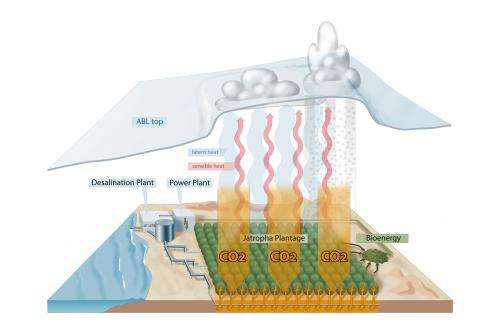Could planting trees in the desert mitigate climate change?

As the world starts feeling the effects of increasing atmospheric carbon dioxide and consequent global temperature rise, researchers are looking for a Plan B to mitigate climate change. A group of German scientists has now come up with an environmentally friendly method that they say could do just that. The technique, dubbed carbon farming, consists in planting trees in arid regions on a large scale to capture CO2. They publish their study today in Earth System Dynamics, a journal of the European Geosciences Union (EGU).
"Carbon farming addresses the root source of climate change: the emission of carbon dioxide by human activities," says first-author Klaus Becker of the University of Hohenheim in Stuttgart.
"Nature does it better," adds Becker's colleague Volker Wulfmeyer, "if we understand and can make use of it in a sustainable manner."
When it comes to sequestering carbon from the atmosphere, the team shows that Jatropha curcas does it better. This small tree is very resistant to aridity so it can be planted in hot and dry land in soil unsuitable for food production. The plant does need water to grow though, so coastal areas where desalinated seawater can be made available are ideal.
"To our knowledge, this is the first time experts in irrigation, desalination, carbon sequestration, economics and atmospheric sciences have come together to analyse the feasibility of a large-scale plantation to capture carbon dioxide in a comprehensive manner. We did this by applying a series of computer models and using data from Jatropha curcas plantations in Egypt, India and Madagascar," says Wulfmeyer.
The new Earth System Dynamics study shows that one hectare of Jatropha curcas could capture up to 25 tonnes of atmospheric carbon dioxide per year, over a 20 year period. A plantation taking up only about 3% of the Arabian Desert, for example, could absorb in a couple of decades all the CO2 produced by motor vehicles in Germany over the same period. With about one billion hectares suitable for carbon farming, the method could sequester a significant portion of the CO2 added to the atmosphere since the industrial revolution.
But there are more advantages. Carbon farming's price tag ranges from 42 to 63 euros per tonne of CO2, making it competitive with other CO2-reduction techniques such as carbon capture and storage. Further, after a few years, the plants would produce bioenergy (in the form of tree trimmings) to support the power production required for the desalination and irrigation systems.
"From our point of view, afforestation as a geoengineering option for carbon sequestration is the most efficient and environmentally safe approach for climate change mitigation. Vegetation has played a key role in the global carbon cycle for millions of years, in contrast to many technical and very expensive geoengineering techniques," explains Becker.
The main limitations to implementing this method are lack of funding and little knowledge of the benefits large-scale plantations could have in the regional climate, which can include increase of cloud coverage and rainfall. The new Earth System Dynamics paper presents results of simulations looking into these aspects, but there is still a lack of experimental data on the effects of greening arid regions. Also, potential detrimental effects such as the accumulation of salt in desert soils need to be evaluated carefully.
The team hopes the new research will get enough people informed about carbon farming to establish a pilot project. "We strongly recommend more emphasis is put on this technology – at both small and large scales – and that more research is done to investigate its benefits in comparison to other geoengineering approaches," concludes Wulfmeyer.
More information: The peer-reviewed scientific article is available online at www.earth-syst-dynam.net/4/237 … /esd-4-237-2013.html
The discussion paper (not peer-reviewed) and reviewers' comments are available at www.earth-syst-dynam-discuss.n … sdd-3-1221-2012.html
Provided by European Geosciences Union

















